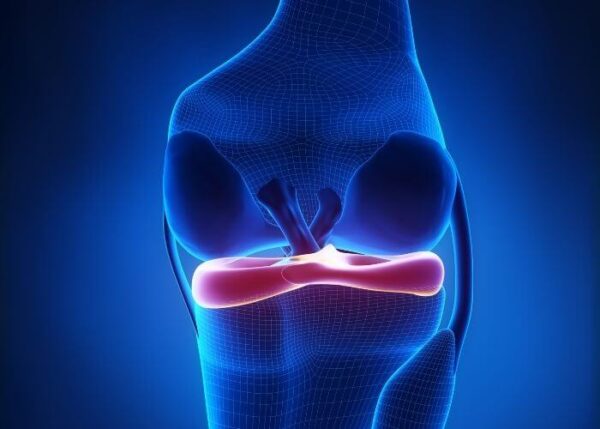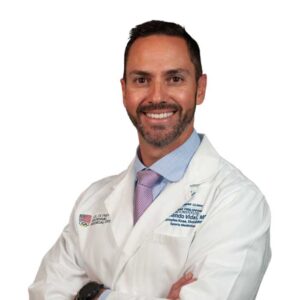What is a Meniscal Deficiency?
The knee has two menisci which are wedge-shaped fibrocartilage which act as shock absorbers. Each year, over 1 million Americans injure their meniscus, which can result in pain, swelling or mechanical symptoms. A damaged, torn or worn meniscus can become degenerative in nature, causing a breakdown on the knee joint due to the missing meniscus tissue. This is called meniscal deficiency and can contribute to a malalignment of the bones of the knee and can trigger the onset of arthritis. Dr. Armando Vidal, orthopedic knee specialist, treats patients in Vail, Aspen and the surrounding Denver, Colorado communities who have a meniscal deficiency.

What causes a meniscal deficiency?
The meniscus has limited blood supply and damage to the fibrous tissue can cause the meniscus to break down, thin out or become jagged. The most common cause of meniscal deficiency is a meniscal tear and / or surgery.
A meniscal tear essentially renders the torn part of the meniscus non-functional. Since this segment of the meniscus can no longer transfer load, it can create a form of meniscal deficiency. The worst tear patterns for creating meniscal deficiency are radial tears and root tears since they are the biomechanical equivalent of having no meniscus at all.
The most common scenario to create meniscal deficiency, though, is post-surgery. Partial meniscectomy is the most common orthopedic procedure performed in the world. During this procedure, a torn, non-repairable piece of meniscus is removed. Depending on how much is taken out – meniscal deficiency can result. So, meniscal preservation with this common procedure is key to avoid this complicated outcome. The medial and lateral meniscus are not equivalent. In particular, the lateral compartment is particularly sensitive to meniscal deficiency and arthritis or chondral injury can result very rapidly after a partial lateral meniscectomy – even in a young patient!!
What are the symptoms of a meniscal deficiency?
Persistent pain, swelling or dysfunction, particularly after an arthroscopic partial meniscectomy, is the most common presentation for symptomatic meniscal deficiency. If you are still having these symptoms more than 3 months out from a meniscal surgery, you should seek an opinion on the persistent cause.
How is a deficiency of the meniscus diagnosed?
Dr. Vidal will obtain a thorough history from the patient, especially past knee problems and current activities. In addition to the physical examination of the knee, he may order an MRI to confirm the diagnosis and look for other injuries. An X-ray is helpful to detect the presence of arthritis and a bone scan may be ordered to test the stress level of the bones.
What is the treatment for meniscal deficiency?
The goal for patients experiencing the symptoms of meniscal deficiency are to provide relief during daily activities. Dr. Vidal aims to help those in the greater Denver, Colorado area to improve knee function, prevent the progression of osteoarthritis and to delay joint replacement.
Non-Surgical Treatments:
- NSAIDs – Non-steroidal anti-inflammatory medication to help alleviate pain and the symptoms associated with meniscal deficiency.
- Physical therapy – Can help strengthen the muscles around the knee, providing stability and helping with correct knee function
- Corticosteroid injections – Helpful for short-term relief, allowing participation in a physical therapy program
- Biologics – Biologic treatments mimic the body’s natural healing process by accelerating the process of healing. Dr. Armando Vidal has extensive and successful experience in administering biologic treatments to treat a variety of knee injuries. The Steadman Clinic and Dr. Vidal are thought leaders on the benefits of biologic treatment.
Surgical treatments:
- Meniscal repair – In some cases, such as a radial split or root tear, restoration of meniscal function with repair of the torn tissue is key to restoring normal biomechanics and load bearing characteristics to the joint
- MAT – Meniscal allograft transplantation – Donor tissue is transplanted into the knee to restore meniscal function
- HTO – High tibial osteotomy – Procedure where a triangular wedge of bone is created in the tibia to unload an affected compartment.Although this does not directly address meniscal deficiency, it works by moving loads out of the diseased compartment and into the other, healthy compartment. In many cases, this is much more predictable and time-tested procedure for restoring function. This is typically used in cases where the knee is “bow-legged” and the damage or meniscal deficiency is in the medial compartment.
- DFO – Distal femoral osteotomy – This is a similar concept to HTO – except on the femoral side. This is typically used to treat knees that are “Knock-kneed” and have damage or meniscal deficiency on the lateral side.
Meniscus Specialist
Are you an athlete who participates in sports that involve squatting, twisting, or turning quickly? If so, you may be at risk of experiencing a meniscal deficiency. Meniscal deficiencies can be caused by a torn or damaged meniscus, which can cause pain and dysfunction of the knee. Knee specialist, Doctor Armando Vidal provides diagnosis as well as surgical and non-surgical treatments for patients in Vail, Aspen, and the surrounding Denver, Colorado communities who are experiencing meniscal deficiencies. Contact Dr. Vidal’s team today!

Locations
180 S Frontage Rd W
Vail, CO 81657
226 Lusher Court
Ste 101
Frisco, CO 80443
322 Beard Creek Road
Edwards, CO 81632


